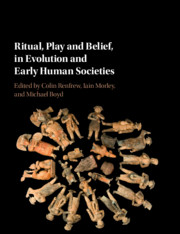196 results
Interdisciplinary approaches to the prehistory of Keros
-
- Journal:
- Archaeological Reports / Volume 64 / November 2018
- Published online by Cambridge University Press:
- 31 December 2018, pp. 67-84
- Print publication:
- November 2018
-
- Article
- Export citation
Acknowledgements
-
- Book:
- Ritual, Play and Belief, in Evolution and Early Human Societies
- Published online:
- 06 December 2017
- Print publication:
- 21 December 2017, pp xiii-xiv
-
- Chapter
- Export citation
Part II - Playing with Belief and Performance in Ancient Societies
-
- Book:
- Ritual, Play and Belief, in Evolution and Early Human Societies
- Published online:
- 06 December 2017
- Print publication:
- 21 December 2017, pp 99-208
-
- Chapter
- Export citation
Dedication
-
- Book:
- Ritual, Play and Belief, in Evolution and Early Human Societies
- Published online:
- 06 December 2017
- Print publication:
- 21 December 2017, pp v-vi
-
- Chapter
- Export citation
Part I - Play and Ritual: Forms, Foundations and Evolution in Animals and Humans
-
- Book:
- Ritual, Play and Belief, in Evolution and Early Human Societies
- Published online:
- 06 December 2017
- Print publication:
- 21 December 2017, pp 21-98
-
- Chapter
- Export citation
Part III - The Ritual in the Game, the Game in the Ritual
-
- Book:
- Ritual, Play and Belief, in Evolution and Early Human Societies
- Published online:
- 06 December 2017
- Print publication:
- 21 December 2017, pp 209-308
-
- Chapter
- Export citation
Notes on the Contributors
-
- Book:
- Ritual, Play and Belief, in Evolution and Early Human Societies
- Published online:
- 06 December 2017
- Print publication:
- 21 December 2017, pp xi-xii
-
- Chapter
- Export citation
Contents
-
- Book:
- Ritual, Play and Belief, in Evolution and Early Human Societies
- Published online:
- 06 December 2017
- Print publication:
- 21 December 2017, pp vii-x
-
- Chapter
- Export citation
Part IV - From Play to Faith? Discussion
-
- Book:
- Ritual, Play and Belief, in Evolution and Early Human Societies
- Published online:
- 06 December 2017
- Print publication:
- 21 December 2017, pp 309-332
-
- Chapter
- Export citation
2 - Introduction: Play as the Precursor of Ritual in Early Human Societies
-
-
- Book:
- Ritual, Play and Belief, in Evolution and Early Human Societies
- Published online:
- 06 December 2017
- Print publication:
- 21 December 2017, pp 9-20
-
- Chapter
- Export citation
Copyright page
-
- Book:
- Ritual, Play and Belief, in Evolution and Early Human Societies
- Published online:
- 06 December 2017
- Print publication:
- 21 December 2017, pp iv-iv
-
- Chapter
- Export citation
Index
-
- Book:
- Ritual, Play and Belief, in Evolution and Early Human Societies
- Published online:
- 06 December 2017
- Print publication:
- 21 December 2017, pp 333-340
-
- Chapter
- Export citation

Ritual, Play and Belief, in Evolution and Early Human Societies
-
- Published online:
- 06 December 2017
- Print publication:
- 21 December 2017
Chapter Two - Cognitive Archaeology and the Making of the Human Mind
- from Part I - Between Myth and Logos
-
-
- Book:
- Eurasia at the Dawn of History
- Published online:
- 28 March 2017
- Print publication:
- 16 January 2017, pp 23-39
-
- Chapter
- Export citation
Chapter 1 - ‘The Unanswered Question’: Investigating Early Conceptualisations of Death
-
-
- Book:
- Death Rituals, Social Order and the Archaeology of Immortality in the Ancient World
- Published online:
- 05 November 2015
- Print publication:
- 19 November 2015, pp 1-12
-
- Chapter
-
- You have access
- HTML
- Export citation
Part VI - Intimations of Immortality: Glimpsing Other Worlds
-
- Book:
- Death Rituals, Social Order and the Archaeology of Immortality in the Ancient World
- Published online:
- 05 November 2015
- Print publication:
- 19 November 2015, pp 349-422
-
- Chapter
- Export citation
Dedication
-
- Book:
- Death Rituals, Social Order and the Archaeology of Immortality in the Ancient World
- Published online:
- 05 November 2015
- Print publication:
- 19 November 2015, pp v-vi
-
- Chapter
- Export citation
Part V - Materiality and Memory
-
- Book:
- Death Rituals, Social Order and the Archaeology of Immortality in the Ancient World
- Published online:
- 05 November 2015
- Print publication:
- 19 November 2015, pp 301-348
-
- Chapter
- Export citation
Part I - Intimations of Mortality
-
- Book:
- Death Rituals, Social Order and the Archaeology of Immortality in the Ancient World
- Published online:
- 05 November 2015
- Print publication:
- 19 November 2015, pp 13-62
-
- Chapter
- Export citation

